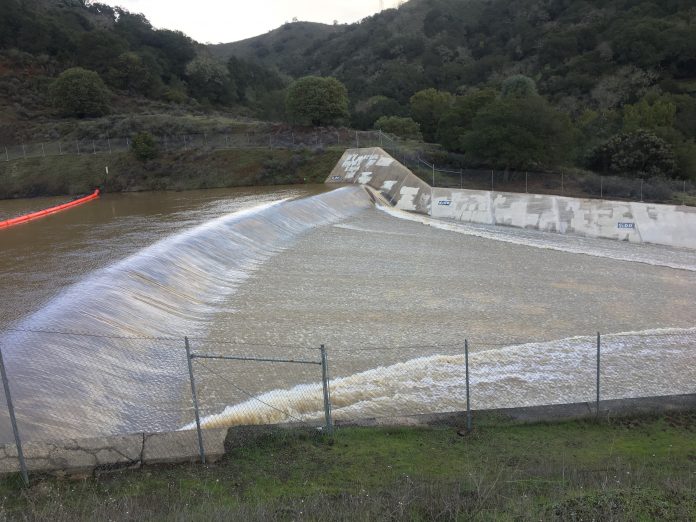
After nearly three consecutive days of rainfall drenched the South County hillsides, Uvas Reservoir began pouring over its emergency spillway Monday morning. While some property owners downstream took precaution, authorities said there was no flood risk associated with Uvas Reservoir surpassing its capacity.
It was the first time this winter that the 9,688-acre-foot reservoir on Uvas Road, in western Morgan Hill, reached beyond its full capacity. As of about 4:30pm Feb. 4, Uvas Reservoir was at 102.7 percent of its capacity, according to the Santa Clara Valley Water District website.
Shortly after the reservoir reached the spillway, the water district issued a statement assuring residents that there was no immediate threat of flooding.
“Water is flowing over the spillway as is normal when a reservoir reaches capacity,” reads the statement on the SCVWD Facebook page. “Spillways are designed to allow for controlled releases and to help regulate flows. They don’t automatically result in flooding. There are currently NO FLOOD RISKS along Uvas Creek associated with the spilling, nor are there any flood risks anticipated. The creek has reached its peak flows and data readings are showing the flow is decreasing.”
Since Feb. 1, when the latest round of storms hit the west coast, more than 2.5 inches of rain have fallen on Morgan Hill, according to the water district’s website. For the winter so far, Morgan Hill has received about 13.74 inches of rain.
The recent storms have had an impact on most waterways in Santa Clara County. Chesbro Reservoir, just west of Morgan Hill, was at about 93 percent of its capacity the afternoon of Feb. 4—up from about 69 percent before the Feb. 1 storms rolled in. Coyote Reservoir in Gilroy was at about 69 percent of its capacity Feb. 4, up from about 51 percent before the latest storms.
Anderson Reservoir in east Morgan Hill, the water district’s largest reservoir, was about 34 percent full Monday afternoon. But water district authorities aim to keep that reservoir low during the winter months to prevent flooding upstream when the level reaches the reservoir’s emergency spillway. Anderson is also regulated by state authorities due to the dam’s seismic deficiencies, and must be kept at about two-thirds full or less.













